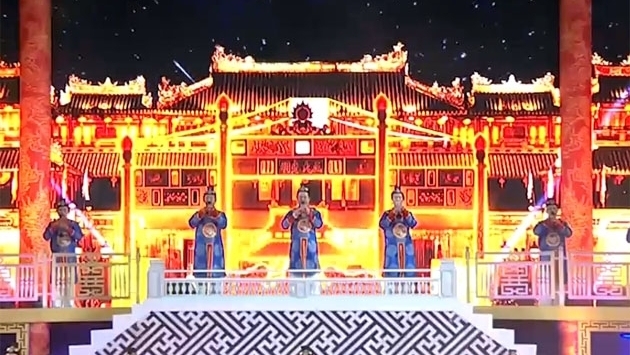
A performance on the closing night of the Hue Festival 2018
This year’s festival was held in the central province of Thua Thien-Hue from April 27 to May 2, attracting thousands of visitors.
The 10th edition of the Hue Festival, an important event of the ancient imperial capital, wrapped up after six days of exciting and impressive activities, said Nguyen Dung, vice Chairman of the provincial People’s Committee at the closing ceremony.
The Hue Festival 2018 offered stages for 786 performers representing 20 countries and territories including Vietnam. Audiences were given the opportunity to enjoy 72 stage shows as well as take part in 37 community activities held by local residents.
It aimed to celebrate 712 years since the founding of Thuan Hoa - Phu Xuan, which is now modern day Hue. The festival was themed ‘Cultural Heritage with Integration and Development: Hue - One Destination, Five World Heritages’.
The five heritage statuses were awarded to the Complex of Hue Monuments, Hue royal court music, woodblocks, the imperial archives of the Nguyen Dynasty and the royal literature on Hue royal architecture.
“Van hien kinh ky”, a highlight of the festival, was an art show which combined a variety of elements: dance, chorus, animation, poetry recitation and music. The 90-minute show featured all of the cultural values of Hue through heritage elements.
Meanwhile, a show titled “Am vong Song Huong” (Resonance of Perfume River) on April 29 involved hundreds of professional and amateur actors and actresses, depicting the life cycle of people living on the rivers from their marriage, giving birth and raising children to passing down their occupation from generation to generation in a joint effort to preserve the Hue cultural values.
The same day, the streets in the silent city of Hue were bustling with performances by art troupes in a street parade. The art troupes from various countries and territories, including Japan, the Republic of Korea, Thailand, Mongolia, Belgium, Poland and Slovakia, brought their native colours to the streets. Audiences enjoyed their performances, which demonstrated their circus skills, along with dance and music, and displayed their costumes.
An “Ao dai” show took place on May 1 evening, exhibiting collections of the Vietnamese national long dress. The show, titled “The Heyday of Hue”, was aimed at depicting “ao dai” in Hue in different eras, with a focus on those worn during the imperial period under the rule of the Nguyen Dynasty (1802-1945).
The designers, hailing from different regions in the country, attempted to get closer to Hue by using symbolic patterns of the city on their designs, besides mimicking the attires of royals and nobles.
Hue city was the imperial capital of Vietnam for hundreds of years. It is home to five UNESCO-recognised heritages, namely the Hue ancient citadel relic complex – a World Cultural Heritage site; Nha Nhac (Hue royal court music) - an intangible cultural heritage item; Nguyen Dynasty wood blocks – a documentary heritage item; Nguyen Dynasty Chau ban (royal administrative documents) – part of the Asia-Pacific Register of UNESCO’s Memory of the World Programme; and literature on Hue royal architecture - a documentary heritage./.
NDO
 Vietnam to host Asian Esports Championships for the first time
Vietnam to host Asian Esports Championships for the first time



